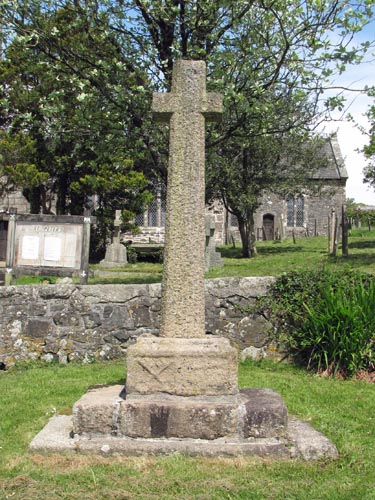
Location: Just outside and to the right of the main churchyard gate at Peter Tavy. O/S Grid Ref: SX/51326/77744 Longitude/Latitude (Degrees+/-): -4.10129/50.58045 Map location: Click here to view map. Purpose: Village Cross. Size: 7 feet 2 inches (2.18 metres) tall. 1 foot 10 inches (0.56 metres) across the arms. Information: The original cross stood outside the main gate to the churchyard, on what was once the village green and was thought to have been erected in about 1350. However, in about 1840, when carriages and hearses were first used for funerals, the cross was found to be blocking the access to the church and was taken down. The crown, or socket stone, was turned upside down and incorporated into the churchyard wall, as a coping stone. Most of the stones used for the pedestal were found piled up in a heap inside the churchyard gate. Unfortunately, nothing can be found of the whereabouts of the original shaft, head or arms. Thanks to a lot of hard work by the villagers, a new cross now stands in the village. This makes use of the original socket stone and all the base stones that could be found. The socket stone, which stands on a pedestal of two steps, measures 2 feet 9 inches by 2 feet 6 inches and is 1 foot 4 inches tall. The top edge is bevelled. A new shaft and cross has been made by Messrs Pascoe of St Ann’s Chapel, Gunnislake, using granite donated by the Dartmoor National Park Authority, from the Merrivale Quarry. This is a very good match for that used in the base and socket stone and the cross has been made in the contemporary style. When put together, the whole picture is said to be associated with St Peter and collectively represents the triumph of good over evil. This requires all the qualities of courage, sacrifice, hope, calm and the help of God through St Peter. A short service to celebrate the restoration of this cross was held at noon on the 1st January 2001. Unfortunately the weather was not good and the service had to be held inside the church, rather than around the cross. Nevertheless, more than 50 interested people turned up to join in the celebration. The cost of the restoration is to be met from fundraising events and, as at January 2001, has not yet been fully met but it is hoped that donations will continue to be made. Just inside the main gate to the Peter Tavy Churchyard, and to the left of the path, is the rugged War Memorial Cross, which is dedicated to those who lost their lives in both World War I and II. |